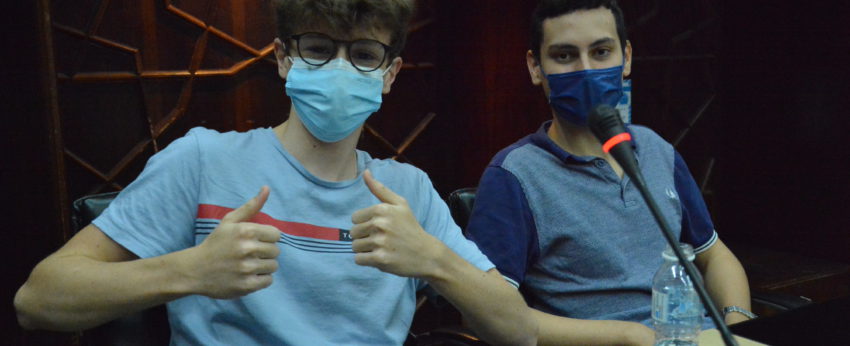SOUVENIR IMAGES OF THE SEMINAR OF RESTITUTION OF THE WORKS AT THE CHANCELLERY OF THE NATIONAL UNIVERSITY OF MALAYSIA (UNIVERSITI KEBANGSAAN MALAYSIA-UKM
Form 5 students, Moral And Civic Education
Throughout 16 hours this academic year, we conducted our investigation on the social cohesion in the Malaysian peninsula.
The partnership with the UNESCO Chair “Social Practices in Intercultural Communication and Social Cohesion” was invaluable to us and we would like to thank Dr. Olmedo, Project Manager of this Chair, who accompanied us throughout the year with rigor and kindness.
Let us explain to you how we proceeded to study one particular aspect of social cohesion in Malaysia.
DISCOVERING MALAYSIAN HISTORY
From the colonial period to the ethnic riots of May 13, 1969, a brief summary of the social history of Malaysia had to be told to us first. It was indeed a necessary prerequisite to study the characteristics of the current social cohesion in Malaysia.
CONCEPTUAL FRAMEWORK AND DATA COLLECTION TECHNIQUES
Social cohesion is not a self-evident term. First, we had to agree on the definition we would use.
More generally, we had to find a common theoretical framework: what operational and measurable concepts could be used? We chose to mobilize the theory of social representations of the French social psychologist Serge Moscovici (1925-2014).
Opinions, beliefs and values were to be analyzed. We therefore opted for a qualitative research, by interviewing Malaysians and expatriates through semi-structured interviews. Thus, we chose to measure one aspect of social cohesion on the Malaysian peninsula by analyzing the views of expatriates and Malaysians.
We learned how to design our interview guidelines with our objective in mind: measuring social representations.
DATA ANALYSIS TECHNIQUES
Vertical thematic analysis
For each interview, we examined the verbatims using sociological concepts such as contextualization, decontextualization, and recontextualization as well as the broader concept of living-togetherness.
Horizontal thematic analyses
We then noted the occurrences and recurrences.
Conclusion
We have finally been able to draw some informed conjectures
Nevertheless, let us keep in mind that being almost all children of French expatriates, the cultural frame of reference remains French. Moreover, we are aware of the limits of our assumptions, since each group worked on a rather limited number of interviews, and we must therefore be careful not to make any generalizations. Finally, the majority of Malaysians interviewed have frequent ties with expatriates, which is far from being the case for the entire population. It is therefore the living togetherness from the point of view of one category of Malaysians that we were able to measure.
SEMINAR
On June 10th, we had the honour to present our work at the chancellery of UKM. We were first warmly welcomed by Distinguished Professor Datuk Dr. Shamsul Amri Baharuddin, Founding Director of the Institute of Ethnic Studies (KITA), as well as by Dr. Eric Olmedo, Principal Research Fellow and Project Manager of the UNESCO Chair on Social Practices in Intercultural Communication and Social Cohesion.
After a welcome coffee, we were seated according to the usual protocol, in the prestigious “bilik Majlis” or Council Room of the Chancellery.
Professor Shamsul Amri Baharuddin and Dr. Eric Olmedo welcomed us and introduced the jury.
Ms. Garland gave her introductory remarks. Raoul presented the school framework for this project. Marion and Thibault presented the conceptual framework and the research methodology.
Each group then defended its work by presenting it and answering questions from the jury. The jury was composed of :
-Associate Professor Dr. Chang Kang Pee, senior researcher at the Institute of Ethnic Studies (KITA)
-Dr. Rachel Chan Suet Kay, Research Fellow, KITA
-Dr. Tainá Bacellar Zaneti, Visiting Scholar, University of Brasilia
-Mr. Jibran Aasli, Exchange student, Institute of Political Studies (Sciences Po) Saint Germain-en-Laye
– Ms. Jasmine Phang, PhD student, KITA.
You will find the power point of the general presentation of our project HERE.
After lunch, Professor Shamsul and Dr. Olmedo gave us certificates.
We would like to thank all the people who accompanied us in this project, Dr Eric Olmedo for his availability and his precious advice, Professor Shamsul Amri Baharuddin for his welcome, and all the members of the jury whose questions allowed us to extend our reflection.
Beyond the objective that we had set ourselves, this project was the occasion of beautiful encounters. It made our view of Malaysian society evolve, of living together in this country that welcomed us, and it somewhat shook up our own social representations.
Catherine Garland
Professor of Economics Social Sciences and Moral and Civic Education.



